Wooden toys supporting children with additional needs
Posted on
Wooden toys supporting children with additional needs
So a brief bit about me to start. I am Naomi (@naomimorris16), mum to two girls aged 7 and 3. My eldest daughter has Autism, and I have worked in the field of special needs for the last 11 years. I am hoping in the blog that follows, you will gain some insight into how wooden toys can be beneficial to all children, but in particular to those with additional needs. Not a day goes by at both home and school where we don’t use at least one wooden toy!
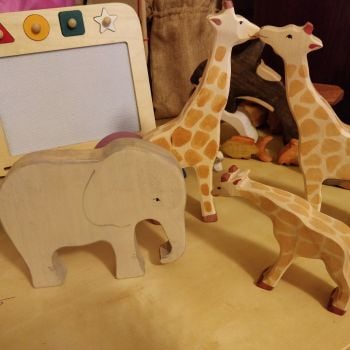
There are so many benefits to using wooden toys, where do you start?
Below is a list of a number of skills that can be developed through the use of wooden toys, but this list is by no means exhaustive
- Coordination
- Fine motor skills
- Grasping
- Crossing the midline
- Turn taking
- Sharing
- Concentration
- Attention
- Balance
- Problem solving
- Resilience
- Story telling
- Sharing ideas
- Control
- Imagination
- Play skills
- Plus much, much more!
What I love about wooden toys is that they are so tactile, and they can be used in so many ways. They are also pretty durable and able to stand the test of time and child led play. Being durable is great, as children can be allowed to explore them more freely without the risk of them getting broken. Another great fact is that with so many of the wooden toys available there is no right or wrong way to play with them, and therefore no worry that the child is going to do the wrong thing. This can give the child more confidence to explore and ‘have a go’. For us this was a big issue with some conventional plastic toys, which resulted in them not being played with, as my daughter was unsure of what was expected of her.
There are many skills that children learn as a natural part of child development, however sometimes children with additional needs don’t pick these up as quickly or need more support to master these skills. Wooden toys provide a variety of fantastic opportunities for children to both learn and practice these key skills that are the building blocks for later in life, For example fine motor skills are important for many tasks such as independent dressing, writing, drawing, using scissors, etc…
There are so many benefits that it would be impossible to cover them all in one blog, so I am going to focus on the following areas, balance, confidence, turn taking and fine motor skills. These are things that we have been working on at home over the last few months.
Balance
This is something we take for granted, and for most of us this comes very naturally. However for some children this can be a real issue, especially if their have issues with their vestibular system (the mechanisms within the ear that help us balance)
There are an array of wooden toys that can help children develop their balance skills, balance boards being the most obvious.
One of the items we love at the minute for helping to develop balance in a fun way is the ‘Trace and Balance Board’ by Viga. Whilst we also have a number of other balance boards that get used regularly for climbing, sliding and rocking, this one is great because you need to shift your balance in different ways to complete the maze. It is not just a simple rock back and forth motion. This has really helped us, as it gives a focus to the activity. As well as helping with developing balance it also helps develop motor planning skills, as you need to plan the moves your body makes in order to move the ball in the correct direction.
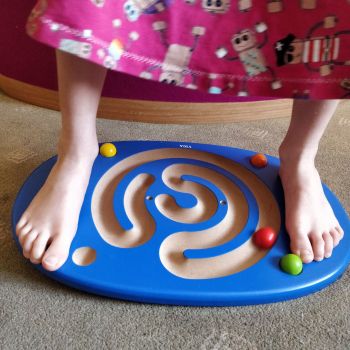
There is also a great competitive element to this board, in that you can use 1, 2, 3 or 4 balls at a time to try and complete the maze, seeing who can complete it with the most balls. Another great use, it timing how quickly you can get the ball from one end of the maze to the other. This can be competition against yourself to see if you can beat your own time, or a competition against others. This also supports turn taking in a really fun way.
Confidence
This is an area in which we have often struggled, both with confidence around people, but also confidence in one’s own ability. Wooden toys are great at supporting this, as there is often no right or wrong way to play with them. This opens up the endless possibilities of open ended play. To children with additional needs this is really important, as society often puts so many constraints on us as to what is expected of us, and that you have to do things in a specific way.
Take for instance the Raduga Grez arcs, these can be used in so many different ways, none of which are right or wrong! Here are just some examples of what my two girls have done with them.
Stacking
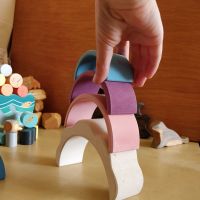
Colour sorting
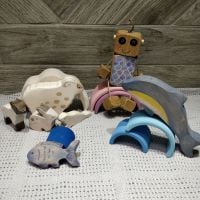
Furniture
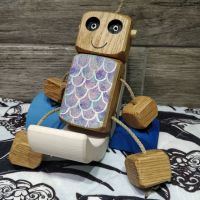
Animal pens
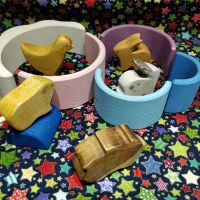
Creative stimulus (still life)
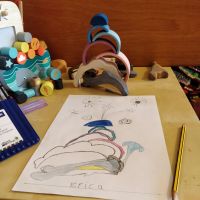
Confidence to talk and communicate can also be developed through the use of wooden toys. The best thing is to follow the child’s lead, look at what they are noticing. Copy the sounds and words they make, begin to show them the rules of conversation. For many children with additional needs talking and functional communication does not always come naturally. To be able to join the child in their world for a short time, for them to notice that you are there, and notice you are responding to them can develop their communication confidence greatly. This can lead on to many further opportunities, such as introducing names of objects, colours, position, etc… the possibilities are endless. However it is important to start where your child is, don’t expect them to join in on your agenda, join them on their learning journey.
Turn Taking
To be honest this is a skill that many children find difficult, even if they don’t have additional needs. It is something that is vitally important throughout life, and is a great thing to learn and practice from a young age.
We love the Floss and Rock balancing game at the minute and this is good for many reasons, one of which is turn taking. Initially I played alongside the girls to model what is expected and help them to take turns if needed. Now that we have been doing this for a while, I can actually take a step back and let the girls play the game together, as they have learnt what is expected through practice. It is great to look at the expressions on their faces as they concentrate to place each piece, and the anticipation as each of them wants it to topple over on the other ones turn.
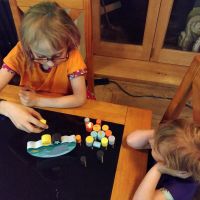
Fine Motor Skills
As I mentioned above, fine motor skills are essential for so many of our day to day activities. What better way than using wooden toys to develop these skills.
Wooden jigsaws are great for developing these skills. The pieces are chunky enough that they can be easily manipulated and turned without bending and breaking. The child can use trial and improvement in the first instance to try and put the puzzle together. Later this would lead to recognizing shapes, colours, patterns, etc…
Arcs, Rainbows, stacking pebbles are also great as they again are chunky enough to grip and can be manipulated and played with in many different ways.
The balancing games, such as the Floss and Rock balancing whale game is also great for this, as the child needs to rotate and place each piece with great care to ensure it doesn’t topple over.

Wooden animals are another great toy for developing fine motor control as many children are naturally drawn to exploring their shape. Young children and children with additional needs also enjoy exploring the texture of the animals, especially when they have tails, manipulating these with their fingers or toes. Children will often not see these shapes as animals initially, and will simply want to explore their shape by manipulating them and looking at them from different angles. Many children enjoy using the animals, as animals and will set up farms and zoos, acting out complex scenes. We often have a full menagerie across the living room floor! The great thing with the animals is they have a right way up, and many children will naturally manipulate the animal into a standing positon, once again practicing their all-important fine motor skills. This is also another great starting point for developing communication.
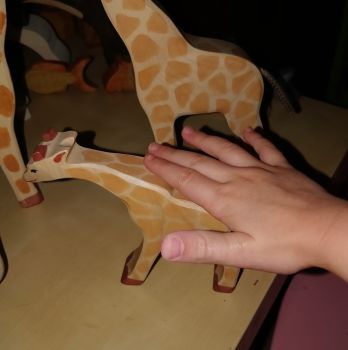
So that was quite a whistle stop tour, but I hope you can see from the brief overview above how versatile wooden toys can be, and they can be used and accessed by children with a variety of different needs. Just because a child does not play with a toy as you envisage it should be played with, does not mean they are playing incorrectly with it. Play is all about learning and developing key skills that will be needed throughout life. Children with additional needs often need more support to develop these skills, and through modelling and playing alongside the child at their level we can help further their development.

Add a comment: